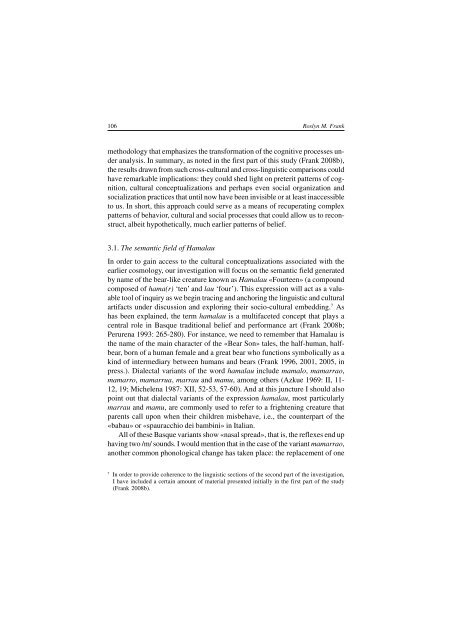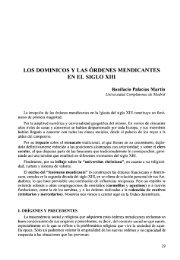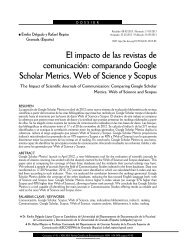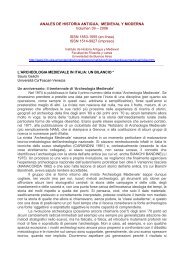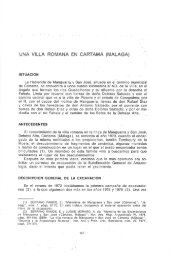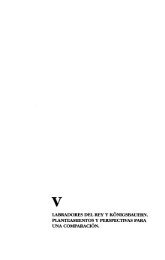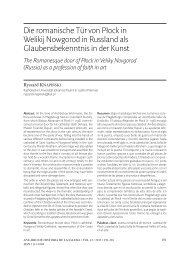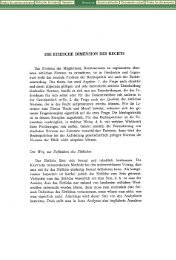Roslyn M. Frank 1.0. Introduction In the first chapter of this ... - Dialnet
Roslyn M. Frank 1.0. Introduction In the first chapter of this ... - Dialnet
Roslyn M. Frank 1.0. Introduction In the first chapter of this ... - Dialnet
Create successful ePaper yourself
Turn your PDF publications into a flip-book with our unique Google optimized e-Paper software.
106 <strong>Roslyn</strong> M. <strong>Frank</strong><br />
methodology that emphasizes <strong>the</strong> transformation <strong>of</strong> <strong>the</strong> cognitive processes under<br />
analysis. <strong>In</strong> summary, as noted in <strong>the</strong> <strong>first</strong> part <strong>of</strong> <strong>this</strong> study (<strong>Frank</strong> 2008b),<br />
<strong>the</strong> results drawn from such cross-cultural and cross-linguistic comparisons could<br />
have remarkable implications: <strong>the</strong>y could shed light on preterit patterns <strong>of</strong> cognition,<br />
cultural conceptualizations and perhaps even social organization and<br />
socialization practices that until now have been invisible or at least inaccessible<br />
to us. <strong>In</strong> short, <strong>this</strong> approach could serve as a means <strong>of</strong> recuperating complex<br />
patterns <strong>of</strong> behavior, cultural and social processes that could allow us to reconstruct,<br />
albeit hypo<strong>the</strong>tically, much earlier patterns <strong>of</strong> belief.<br />
3.1. The semantic field <strong>of</strong> Hamalau<br />
<strong>In</strong> order to gain access to <strong>the</strong> cultural conceptualizations associated with <strong>the</strong><br />
earlier cosmology, our investigation will focus on <strong>the</strong> semantic field generated<br />
by name <strong>of</strong> <strong>the</strong> bear-like creature known as Hamalau «Fourteen» (a compound<br />
composed <strong>of</strong> hama(r) ‘ten’ and lau ‘four’). This expression will act as a valuable<br />
tool <strong>of</strong> inquiry as we begin tracing and anchoring <strong>the</strong> linguistic and cultural<br />
artifacts under discussion and exploring <strong>the</strong>ir socio-cultural embedding. 7 As<br />
has been explained, <strong>the</strong> term hamalau is a multifaceted concept that plays a<br />
central role in Basque traditional belief and performance art (<strong>Frank</strong> 2008b;<br />
Perurena 1993: 265-280). For instance, we need to remember that Hamalau is<br />
<strong>the</strong> name <strong>of</strong> <strong>the</strong> main character <strong>of</strong> <strong>the</strong> «Bear Son» tales, <strong>the</strong> half-human, halfbear,<br />
born <strong>of</strong> a human female and a great bear who functions symbolically as a<br />
kind <strong>of</strong> intermediary between humans and bears (<strong>Frank</strong> 1996, 2001, 2005, in<br />
press.). Dialectal variants <strong>of</strong> <strong>the</strong> word hamalau include mamalo, mamarrao,<br />
mamarro, mamarrua, marrau and mamu, among o<strong>the</strong>rs (Azkue 1969: II, 11-<br />
12, 19; Michelena 1987: XII, 52-53, 57-60). And at <strong>this</strong> juncture I should also<br />
point out that dialectal variants <strong>of</strong> <strong>the</strong> expression hamalau, most particularly<br />
marrau and mamu, are commonly used to refer to a frightening creature that<br />
parents call upon when <strong>the</strong>ir children misbehave, i.e., <strong>the</strong> counterpart <strong>of</strong> <strong>the</strong><br />
«babau» or «spauracchio dei bambini» in Italian.<br />
All <strong>of</strong> <strong>the</strong>se Basque variants show «nasal spread», that is, <strong>the</strong> reflexes end up<br />
having two /m/ sounds. I would mention that in <strong>the</strong> case <strong>of</strong> <strong>the</strong> variant mamarrao,<br />
ano<strong>the</strong>r common phonological change has taken place: <strong>the</strong> replacement <strong>of</strong> one<br />
7 <strong>In</strong> order to provide coherence to <strong>the</strong> linguistic sections <strong>of</strong> <strong>the</strong> second part <strong>of</strong> <strong>the</strong> investigation,<br />
I have included a certain amount <strong>of</strong> material presented initially in <strong>the</strong> <strong>first</strong> part <strong>of</strong> <strong>the</strong> study<br />
(<strong>Frank</strong> 2008b).


